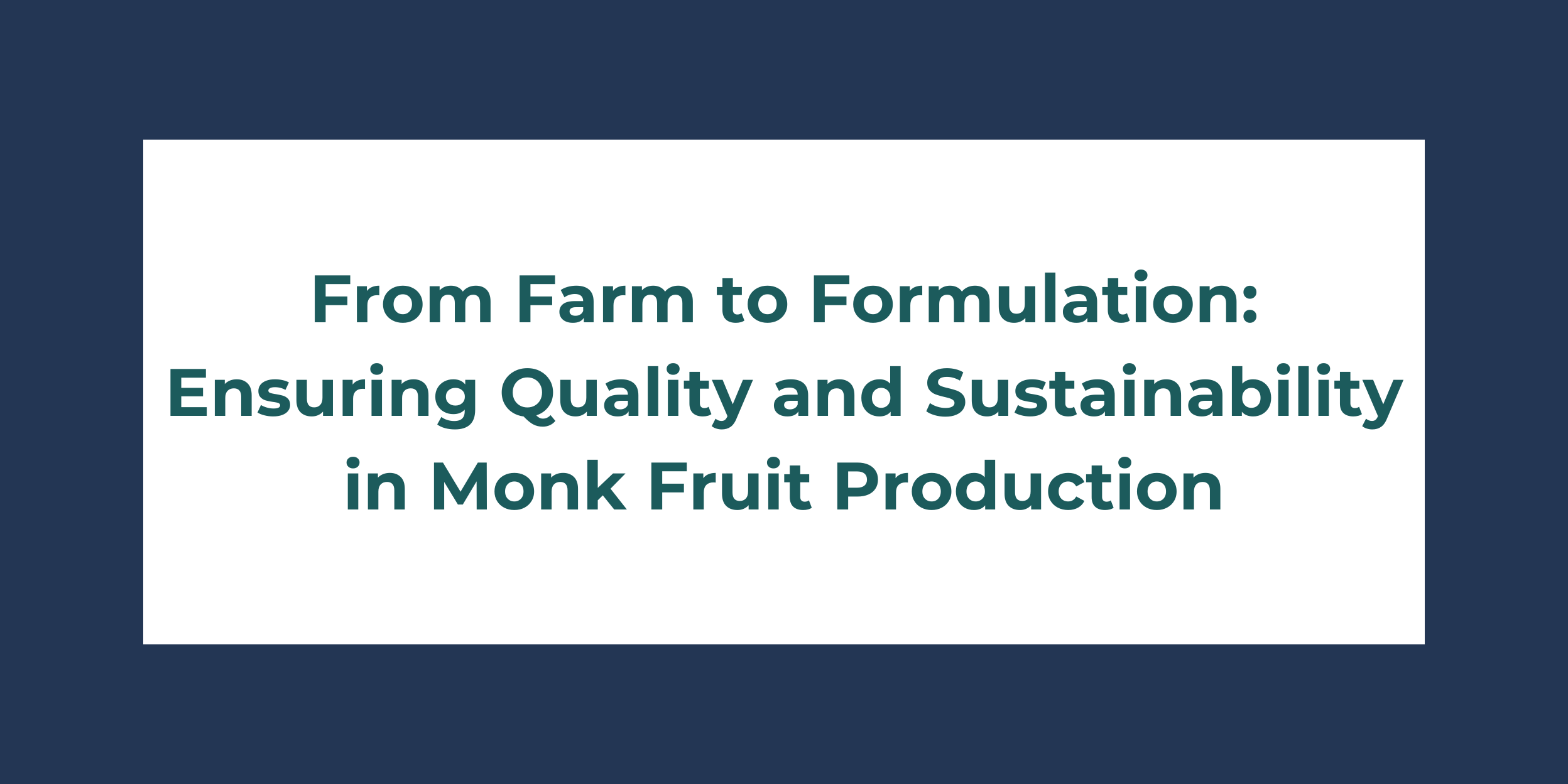Introduction
Monk fruit, known for its natural sweetness and zero-calorie content, has emerged as a popular alternative to traditional sugar.
As consumer demand for healthier and more sustainable products grows, the importance of ensuring quality and sustainability in monk fruit production has never been greater.
This blog explores the journey of monk fruit from farm to formulation, highlighting the key practices that ensure its quality and sustainability.
The Journey Begins: Cultivating Monk Fruit
Sustainable Farming Practices
Organic Farming
Its farming begins with sustainable agricultural practices. Many producers prioritize organic farming methods, avoiding synthetic pesticides and fertilizers.
Organic farming not only protects the environment but also ensures that the final product is free from harmful chemicals, appealing to health-conscious consumers.
Biodiversity and Soil Health
Maintaining biodiversity and soil health is crucial in cultivation.
Farmers use crop rotation, cover cropping, and composting to enhance soil fertility and prevent erosion.
These practices contribute to the long-term sustainability of the land, ensuring that monk fruit production can continue for generations without depleting natural resources.
Ethical Labor Practices
Fair Wages and Working Conditions
Ethical labor practices are integral to sustainable monk fruit production.
Ensuring that farmers and workers receive fair wages and work in safe conditions is essential.
Companies that prioritize ethical labor practices not only support the well-being of their workers but also enhance the reputation and credibility of their products.
Community Support
Supporting local communities is another aspect of ethical labor practices.
Many monk fruit producers invest in community development projects, such as building schools and healthcare facilities.
These initiatives foster goodwill and create a positive impact on the communities involved in monk fruit production.
Harvesting and Processing: Ensuring Quality
Harvesting Techniques
Timing and Method
The quality is heavily influenced by the timing and method of harvesting.
Fruits must be picked at the peak of ripeness to ensure maximum sweetness and nutritional value.
Careful handling during harvesting prevents damage to the fruit, preserving its quality for further processing.
Traditional Methods
In some regions, traditional harvesting methods are employed to maintain the cultural heritage of monk fruit production.
These methods often involve hand-picking the fruit, which can be more labor-intensive but helps preserve the integrity of the fruit and supports local traditions.
Processing and Extraction
Gentle Processing Techniques
Once harvested, monk fruit undergoes processing to extract its natural sweetness.
Gentle processing techniques, such as water extraction, are preferred to retain the fruit’s natural compounds and avoid the introduction of artificial additives.
This ensures that the final product remains pure and high-quality.
Quality Control
Strict quality control measures are essential during the processing stage.
Regular testing for purity, sweetness, and safety ensures that only the best quality monk fruit extract reaches the market.
Adhering to international quality standards, such as ISO and HACCP, helps maintain consistency and consumer trust.
Formulating with Monk Fruit
Versatility in Applications
Food and Beverage Industry
It’s versatility makes it an ideal ingredient for various applications in the food and beverage industry.
From beverages and dairy products to baked goods and confectionery, monk fruit can be used to create a wide range of sugar-free and low-calorie products.
Its ability to blend seamlessly with other ingredients makes it a valuable asset for formulators.
Nutraceuticals and Supplements
In the nutraceutical and supplement industry, monk fruit is used to enhance the palatability of products without adding calories.
It is particularly popular in protein powders, vitamins, and herbal supplements, where it provides a natural sweetness that appeals to health-conscious consumers.
Consumer Preferences
Clean Label and Transparency
Today’s consumers are increasingly seeking clean label products with transparent ingredient sourcing.
Monk fruit aligns perfectly with this trend, as it is a natural, non-GMO sweetener with a clear origin story.
Highlighting these attributes on product labels can attract health-conscious consumers and build brand loyalty.
Taste and Texture
Ensuring that products formulated with monk fruit meet consumer expectations for taste and texture is crucial.
Advances in formulation technology have made it possible to create products that closely mimic the taste and mouthfeel of sugar-sweetened versions.
Conducting sensory evaluations and consumer testing helps fine-tune formulations to achieve the desired taste profile.
Sustainability in Monk Fruit Production
Environmental Impact
Reducing Carbon Footprint
Sustainable monk fruit production involves minimizing the environmental impact at every stage.
This includes reducing the carbon footprint through energy-efficient processing methods, sustainable packaging, and transportation.
Companies that adopt these practices can position themselves as environmentally responsible, appealing to eco-conscious consumers.
Water Conservation
Water conservation is another critical aspect of sustainable monk fruit production.
Implementing efficient irrigation systems and water recycling techniques helps reduce water usage, preserving this vital resource for future generations.
Conclusion
Ensuring the quality and sustainability of monk fruit production requires a holistic approach, from sustainable farming practices and ethical labor to careful harvesting, processing, and formulation.
By committing to these principles, businesses can meet the growing demand for natural, healthful, and environmentally responsible products.
Embracing sustainability and quality not only benefits the planet and local communities but also drives long-term success and consumer loyalty in the competitive market of natural sweeteners.








